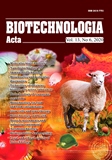ISSN 2410-7751 (Print)
ISSN 2410-776X (Online)

Biotechnologia Acta V. 13, No 6, 2020
Р. 50-57, Bibliography 23, English
Universal Decimal Classification: 577.112:57.083.3
https://doi.org/10.15407/biotech13.06.050
POLYCLONAL ANTIBODIES AGAINST HUMAN PLASMINOGEN: PURIFICATION, CHARACTERIZATION AND APPLICATION
T. A. Yatsenko, S. M. Kharchenko
Palladin Institute of Biochemistry of NAS of Ukraine
The plasminogen/plasmin system plays a crucial role in fibrinolysis and regulation of cell functions in a wide range of normal and pathological processes. Investigation of plasminogen/plasmin functions requires the availability of well-characterized and effective molecular tools, such as antibodies. In the present work, the isolation and characterization of rabbit polyclonal antibodies against human plasminogen are described and approaches for the identification of plasminogen and its fragments using the purified antibodies are demonstrated. For the antibodies isolation, standard animal immunization and blood collection procedures, serum isolation, protein salting out and affinity chromatography were performed. For the antibodies characterization and application, the following methods were used: enzyme linked immunoassay (ELISA), Western blotting, FITC-protein conjugation, flow cytometry and spectrofluorometry. The obtained polyclonal rabbit anti-human plasminogen antibodies interacted with human Glu- and Lys-plasminogen, kringles 1-3 and 1-4 of plasminogen, mini-plasminogen, the heavy and light chain of plasmin. We propose the application of anti-plasminogen antibodies for the direct ELISA, Western blot analysis, and for flow cytometry and spectrofluorometric analysis of plasminogen binding with cells. The obtained anti-plasminogen antibodies are promising tools for the investigation of plasminogen/plasmin system functions, either fibrinolytic or signaling.
Key words:. plasminogen, rabbit polyclonal antibodies, affinity chromatography, ELISA, Western blotting, FITC-coupling, flow cytometry, spectrofluorometry.
© Palladin Institute of Biochemistry of National Academy of Sciences of Ukraine, 2020
References
1. Lijnen H. R. Elements of the fibrinolytic system. Ann N Y Acad Sci. 2001, V. 936, P. 226?236. https://doi.org/10.1111/j.1749-6632.2001.tb03511.x
2. Deryugina E., Quigley J. P. Cell surface remodeling by plasmin: a new function for an old enzyme. J. Biomed. Biotechn. 2012, V. 2012, Art IDn564259, 21 p. https://doi.org/10.1155/2012/564259
3. Miles L. A., Castellino F. J., Gong Y. Critical role for conversion of glu-plasminogen to Lys-plasminogen for optimal stimulation of plasminogen activation on cell surfaces. Trends Cardiovasc. Med. 2003, 13 (1), 21?30. https://doi.org/10.1016/s1050-1738(02)00190-1
4. Tykhomyrov A. A., Shram S. I., Grinenko T. V. Role of angiostatins in diabetic complications. Biomed. Khim. 2015, 61 (1), 41?56. (In Russian). https://doi.org/10.18097/pbmc20156101041
5. Miles L. A., Parmer R. J. Plasminogen Receptors: The First Quarter Century. Semin. Thromb. Hemost. 2013, 39 (4), 329–337. https://doi.org/10.1055/s-0033-1334483
6. Suelves M., L?pez-Alemany R., Llu?s F., Aniorte G., Serrano E., Parra M., Carmeliet P., Mun?oz-Ca?noves P. Plasmin activity is required for myogenesis in vitro and skeletal muscle regeneration in vivo. Blood. 2002, 99 (8), 2835?2844. https://doi.org/10.1182/blood.v99.8.2835
7. Palumbo J. S., Talmage K. E., Liu H., La Jeunesse C. M., Witte D. P., Degen J. L. Plasminogen supports tumor growth through a fibrinogen-dependent mechanism linked to vascular patency. Blood. 2003, 102 (8), 2819?2827. https://doi.org/10.1182/blood-2003-03-0881
8. Guti?rrez-Fern?ndez A., Gingles N. A., Bai H., Castellino F. J., Parmer R. J., Miles L. A. Plasminogen enhances neuritogenesis on laminin-1. J. Neurosci. 2009, 29 (40), 12393?12400. https://doi.org/10.1523/JNEUROSCI.3553-09.2009
9. Heissig B., Salama Y., Takahashi S., Osada T., Hattori K. The multifaceted role of plasminogen in inflammation. Cell Signal. 2020, V. 75, P. 109761. https://doi.org/10.1016/j.cellsig.2020.109761
10. Petrenko O. M., Tykhomyrov A. A. Levels of angiogenic regulators and MMP-2, -9 activities in Martorell ulcer: a case report. Ukr. Biochem. J. 2019, 91(1), 100-107. https://doi.org/10.15407/ubj91.01.100
11. Deutsch D. G., Mertz E. T. Plasminogen: purification from human plasma by affinity chromatography. Science. 1970, 170 (3962), 1095?1096. https://doi.org/10.1126/science.170.3962.1095
12. Norrman B., Wall?n P., R?nby M. Fibrinolysis mediated by tissue plasminogen activator. Disclosure of a kinetic transition. Eur. J. Biochem. 1985, 149 (1), 193?200. https://doi.org/10.1111/j.1432-1033.1985.tb08911.x
13. Tykhomyrov A. A., Yusova E. I., Diordieva S. I., Corsa V. V., Grinenko T. V. Production and characteristics of antibodies against k1-3 fragment of human plasminogen. Biotechnol. acta. 2013, 6 (1), 86?96. (In Ukrainian). https://doi.org/10.15407/biotech6.01.086
14. Guidelines for the Production of Polyclonal and Monoclonal Antibodies in Rodents and Rabbits. Research Animal Resource Center ? Memorial Sloan-Kettering Cancer Center ? Weill Cornell Medical College. 2015, 13 p.
15. Harlow E., Lane D. Antibodies. A Laboratory Manual. Cold Spring Harbor Laboratory. 1988, 355 p.
16. Laemmli U. K. Cleavage of structural proteins during the assembly of the head of bacteriophage T4. Nature. 1970, 227 (5259), 680?685. https://doi.org/10.1038/227680a0
17. Tsang V. C., Peralta J. M., Simons A. R. Enzyme-linked immunoelectrotransfer blot techniques (EITB) for studying the specificities of antigens and antibodies separated by gel electrophoresis. Methods Enzymol. 1983, V. 92, P. 377?391. https://doi.org/10.1016/0076-6879(83)92032-3
18. Roka-Moya Y. M., Zhernossekov D. D., Grinenko T. V. Plasminogen/plasmin influence on platelet aggregation. Biopolym. Cell. 2012, 28 (5), 352?356. https://doi.org/10.7124/bc.000077
19. Abad M. C., Arni R. K., Grella D. K., Castellino F. J., Tulinsky A., Geiger J. H. The X-ray crystallographic structure of the angiogenesis inhibitor angiostatin. J. Mol. Biol. 2002, 318 (4), 1009?1017. https://doi.org/10.1016/S0022-2836(02)00211-5
20. Tykhomyrov A. A., Zhernosekov D. D., Grinenko T. V. Plasminogen modulates formation and release of platelet angiogenic regulators. Ukr. Biochem. J. 2020, 92(1), 31-40. https://doi.org/10.15407/ubj92.01.031
21. Radziwon-Balicka A., Moncada de la Rosa C., Zielnik B., Doroszko A., Jurasz P. Temporal and pharmacological characterization of angiostatin release and generation by human platelets: implications for endothelial cell migration. PLoS One. 2013, 8 (3), e59281. https://doi.org/10.1371/journal.pone.0059281
22. Miles L. A., Ginsberg M. H., White J. G., Plow E. F. Plasminogen interacts with human platelets through two distinct mechanisms. J. Clin. Invest. 1986, 77 (6), 2001?2009. https://doi.org/10.1172/JCI112529
23. Montague S. J., Andrews R. K., Gardiner E. E. Mechanisms of receptor shedding in platelets. Blood. 2018, 132 (24), 2535?2545. https://doi.org/10.1182/blood-2018-03-742668
24. Tangen O., Berman H. J. Gel Filtration of Blood Platelets: A Methodological Report. In: Platelet Function and Thrombosis. Advances in Experimental Medicine and Biology, vol 34. Mannucci P. M., Gorini S. (eds). Springer, New York, NY. 2012, 1 p. https://doi.org/ 10.1007/978-1-4684-3231-2_13
25. Walkowiak B., Kralisz U., Michalec L., Majewska E., Koziolkiewicz W., Ligocka A., Cierniewski C. S. Comparison of platelet aggregability and P-selectin surface expression on platelets isolated by different methods. Thromb. Res. 2000, 99 (5), 495?502. https://doi.org/10.1016/s0049-3848(00)00282-6

